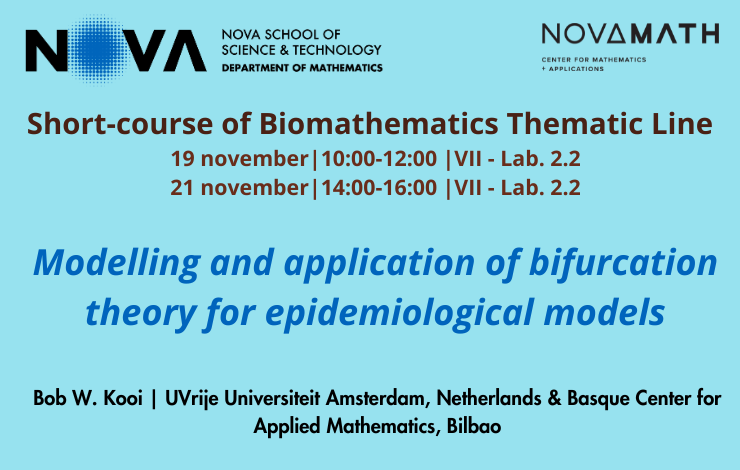MENU
13-11-2024

The Center of Mathematics and Applications (NOVA Math), promote the Short-course of Biomathematics Thematic Line, organized jointly with the Analysis group, with the title: “Modelling and application of bifurcation theory for epidemiological models”. Bob W. Kooi (UVrije Universiteit Amsterdam, Netherlands & Basque Center for Applied Mathematics, Bilbao) is the speaker.
Lecture 1: Tuesday, 19 November 2024, from 10:00 to 12:00.
Lecture 2: Thursday, 21 November 2024, from 14:00 to 16:00.
Abstract: A first introduction into the theory of bifurcation analysis is given by the study of the normal forms of basic bifurcations of equilibriums. The bifurcations that occur in the classical models in Epidemiology and Ecology are described. The formulation the models and the rationale behind their derivation is discussed in detail.
Of the important equilibrium bifurcations: transcritical, tangent, Pitchfork and Hopf bifurcations the dynamical behavior depending on parameter values are explained. The application of bifurcation theory as a mathematical tool is in modeling Dengue fever as used as an example where experimental data are used to estimate the parameter values. This allows for the study of the effects on the spread of the disease and to assess the effects of disease control.
In order to reduce the dimension of the models often time scale separation techniques are use and this approach is discussed and analysed in detail whereby bifurcation theory is an important mathematical tool.
The analysis of the Rozenzweig-MacArthur predator-prey model is explained by following step by step the procedure performing a bifurcation analysis using the computer package MatCont running in in Matlab and this gives insight into the bifurcation theory connected with its implement in computer packages. Another aim is the discuss principles behind continuation techniques including numerical issues.